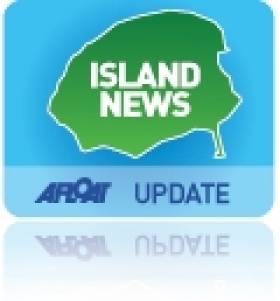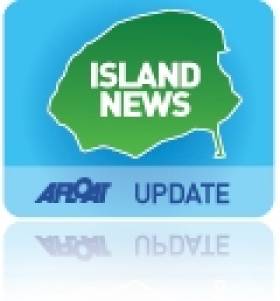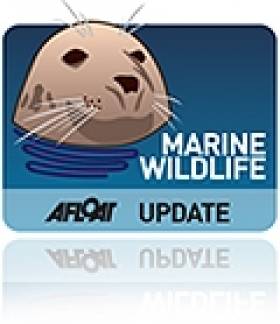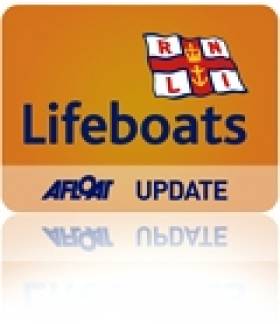Displaying items by tag: Dalkey Island
Currachs, Old Gaffers & Tallships to Gather in Dublin Bay Races over June Bank Holiday
#Currachs&Tallships – Three events are scheduled to take by place in Dublin Bay over the June Bank Holiday, writes Jehan Ashmore
As previously reported on Afloat.ie, Coliemore Harbour in Dalkey is where a pair of racing currachs for the Begnet's Boat Project are to be launched on Saturday (1 June) and rowed if not raced! across the sound to Dalkey Island.
The currachs are to be constructed locally with the support of the community which is to foster and strengthen creative, spiritual and maritime links between the town (the former medieval port for Dublin) and Dalkey Island.
In addition the community are invited to take part in accompanying projects, one in which includes a 'St. Begnet's Cookbook' which features seafaring recipes by Elaine Flood which are to be put to good use in feeding the boat-building team during the month-long currach construction.
Currently there is a fundraiser campaign with a reward scheme, noting a countdown of only three days remain before closing date. To learn more about this project and to help in funding, click HERE.
The Old Gaffers Association (OGA) which as previously reported on Afloat.ie are to celebrate their Golden Jubilee, where also on Saturday (1 June) larger craft are to participate for the RMS Leinster Trophy from Dun Laoghaire Harbour and surrounding islands and buoys to Poolbeg Y & BC Ringsend.
On Sunday (2 June), the Howth 17's are also to join in the action on the Liffey with a 'race between the bridges' having set off from Poolbeg, where most of the Dublin OGA branch members are based.
On the following Monday, (3 June) is the race for the new OGA Asgard Trophy. The trophy is made from a variety of spare timbers saved by John Kearon, conservator of Erskine Childers' Asgard.
All being well, the gathering of the OGA's one design class of classically gaff-rigged boats should present a glorious sight in Dublin Bay, with fellow Old gaffers fleets joining in from the Isle of Man, Scotland and England as part of the Golden Jubilee's clockwise cruise circuit of the UK.
The third event is the arrival of six tallships from Belfast which are to descend in the capital port on Friday (31 May). They will remain in port over the four-day long inaugural Dublin Port River Festival, an initiative of Sail Training Ireland.
This can only add to a sea of masts, albeit not like last year's Tall Ships Festival, yet however is still something to look forward... during those early days of June.
Begnet’s Boat-Building Currach Project Bound for Dalkey Island
#Begnet'sBoats – A community-led project to build a pair of currachs in Dalkey, Co. Dublin is gaining momentum as locals participate in a goal to launch the boats from Coliemore Habour on 1 June, writes Jehan Ashmore.
The Begnet's Boats Project is the vision of local resident Liz Murray who was inspired to bring the community together in a creative approach and to reflect the rich maritime heritage of Dalkey and local saint of St. Begnet. There are two churches in her name, one located in the town and the other on the small island lying some 300m offshore.
Murray has assigned a team to construct the pair of 'racing' currachs and they are to be led by boat-builder Mark Reddon. In addition the community are invited to take part in accompanying projects, one in which includes a 'St. Begnet's Cookbook' which features seafaring recipes by Elaine Flood.
The highlight of the venture will be a parade of the boats which are to be carried upside down, as is the traditional manner, from Castle Street, the town's main street to the coast at Coliemore Harbour.
From there the currachs, to be named 'Naomh Beagnait 1 & 2' will ceremoniously be rowed if not raced! across Dalkey Sound to the island, where the first reference to St. Begnet on the island dates to 700 A.D.
Information in how to get involved including a reward scheme and fundraiser countdown campaign can be viewed by visiting: www.fundit.ie/project/begnets-boats-project-2013
It would seem that the only way to get to Dalkey Island these days is by privately-owned craft and as previously reported on Afloat.ie, Coliemore Harbour has not had access to a ferry boat service in recent years. The harbour has been the traditional embarkation point for generations.
Currently engineering consultants are carrying out a structural survey and report due to be completed around May. The consultants were contracted by Dun Laoghaire-Rathdown County Council who had deemed the harbour unsafe and not suitable for use by a commercial ferry operator.
The delay in restoring a licensed ferry service has led to a campaign by locals, businesses and community groups who have feared that an alternative longer term ferry service would operate instead from either Bulloch or Dun Laoghaire Harbour.
Helicopters Role in Proposed Upgrade of Dalkey Island Harbour
#DALKEY ISLAND FERRY – Up to 500 helicopter flights over an 8-day timeframe could be operating across the 300m wide Dalkey Sound, following proposed plans to upgrade the island's slipway harbour were unveiled last week, reports Jehan Ashmore.
According to consultants that carried out a report for Dun Laoghaire-Rathdown County Council, the proposed upgrade of the slipway, under a PART 8 Scheme, could see a site near Sorrento Point on Coliemore Road, as the desired landing location to load helicopters heading for the island with machine plant, equipment and materials.
Under the proposed development of up to 12 weeks to complete, work would involve raising the existing slipway to create a stepped top surface, widening of the existing channel, a new raised pier section with transitional steps, a handrail, mooring rings and an access ladder.
The consultants Malachy Walsh & Partners and Shaffrey Associate Architects have however indicated that Dun Laoghaire may be an alternative helicopter embarkation point. Total construction costs of the project are estimated at approximately €228,000, however should Dun Laoghaire be opted instead, this would double lift costs compared to Dalkey, adding about 84% to the overall helicopter costs.
The use of helicopter transportation is not new to the island, as in the early 1990's works on the island harbour also saw flights running back and forth to the grounds of the Dalkey Island Hotel, now occupied by a luxury apartment complex.
The consultant's report also adds that Dalkey Island is designated as a Special Protection Area (SPA) for roosting the common, artic & roseate tern species in accordance with the requirements of the EU Habitats Directive 1992, however given the scale and the location of the slipway works, the report concludes that a full appropriate assessment screening would not be required for the Dalkey SPA because it is considered not to have a significant effect on this site.
As previously reported on Afloat.ie the island has also been proposed as a Special Area of Conservation (SAC) as part of six Natura 2000 sites within Irish waters.
Plans and particulars of the proposed slipway upgrade of the Dalkey Island PART 8 Scheme development including timescale of public consultation process, can be found in greater detail to include downloadable PDF documents, by following this LINK.
Six New Marine Sites Chosen for Conservation
#MarineWildlife - Minister for Arts, Heritage and the Gaeltacht Jimmy Deenihan announced on Wednesday the proposal of six new marine sites for designation as Special Areas of Conservation (SACs) to protect marine habitats and species listed on the 1992 EU Habitats Directive.
The six sites around the Irish coast represent habitats (sandbanks and reefs) and/or marine wildlife (specifically dolphins and porpoises) identified as insufficiently represented in the list of Irish SACs at the EU Commission's Marine Atlantic Biogeographic Seminar in 2009. These sites are:
- Blackwater Bank, Co Wexford (Sandbank)
- West Connacht Coast (Bottlenose dolphin)
- Hempton’s Turbot Bank, Co Donegal (Sandbank)
- Rockabill to Dalkey Island, Co Dublin (Reefs and harbour porpoise)
- Porcupine Bank Canyon, off Kerry (Reefs)
- South-East Rockall Bank (Reefs)
The designation of marine SACs is scheduled for completion in Europe in 2012, and according to the minister, this list of six additional SACs will constitute Ireland’s contribution to that process.
In a statement, the department said: "These six SAC sites will protect a range of habitats and species including sandbanks, deep sea coral reefs, dolphins off the Atlantic coast and harbour porpoises found in Dublin Bay.
"These sites are part of a European network of nature conservation sites known as Natura 2000 which was established with the aim of preserving our rich natural heritage for future generations."
Among the new designations are two offshore sites at the Porcupine Bank Canyon and the South East Rockall Bank "contain excellent examples of offshore fauna associated with geogenic reef (ie reef made of rock). Considering the extent of Ireland’s offshore maritime area alongside the value and vulnerability of deep sea biodiversity therein, these two sites represent a modest but highly significant contribution to the Irish SAC network."
Two new inshore areas are being proposed in the west of Ireland to protect the bottlenose dolphin. The department is currently co-funding a multi-annual research programme to further understand the ecology of this species in this coastal region.
Meanwhile, the inshore site off Dublin from Rockabill to Dalkey Island is also being proposed both for the harbour porpoise, and for geogenic reef to address a gap in the SAC network for this habitat type in the northern part of the Irish Sea.
As previously reported on Afloat.ie, the oil exploration company behind the Dalkey Island Prospect has spoken out over the Rockabill to Dalkey Island designation, claiming it had not been given advance information of the decision.
Providence Resources says maps provided by the department appear to show and overlap between the location for a seismic survey and the new SAC area, which would make any development for resource extraction "extremely problematic".
Last week the Irish Whale and Dolphin Group (IWDG) expressed concern over the potential impact of the 2D seismic survey at Dalkey Island on harbour porpoises in Dublin Bay.
Dalkey Island Forum
#DALKEY ISLAND – St. Patrick's Church of Ireland, Dalkey will be the venue for the Dalkey Island Forum, on 24 November between 9:30am - 1:30pm.
The forum will comprise of a panel of leading experts with presentations providing an overview of the unique archaeology, history and architectural features of this special island on the coast off south Co. Dublin.
The forum will also consider issues around access and management of the Island in the context of proposals by Dun Laoghaire Rathdown Council to 'improve' the landing place, while at the same time opposing moves to restore the historic ferry link from Coliemore Harbour.
Below is a list of speakers and topics arranged for the forum which is sponsored by Dalkey Civic Trust.
Dr Neill Brady, The Archaeological Diving Company: 'The Archaeology of Dalkey Island'
Dr Edel Bhreathnach, Michael O'Cleirigh Institute UCD: 'St Begnet and Dalkey's early Christian heritage'
Jason Bolton, Conservation Consultant: 'Conservation of the architectural heritage of the Dalkey Islands'
Darina Tully, Maritime Archaeologist: 'Dalkey as a Maritime Cultural Landscape'
Admission is €12 at the door or €10 per person (pre-registered if booked online click HERE) - to include tea, coffee and refreshments. For further details contact: Reg McCabe, Dalkey Civic Trust on 086 242 0962
Birdwatch Ireland: Dalkey Island Evening Viewings
#MARINE WILDLIFE – The South Dublin Branch of BirdWatch Ireland is organising outdoor meetings over the summer which include watching terns and other species during July at Coliemore Harbour, Dalkey, writes Jehan Ashmore.
The first meeting is Tuesday 3rd July (6.30-8pm) and every other Tuesday during the month. None-members of Birdwatch Ireland are invited to the evenings which are run in conjunction with Dun Laoghaire-Rathdown County Council (DLRCoCo).
During the seabird viewing evenings, BirdWatch Ireland experts will be on hand to show the breeding terns and other birds whose habitat is not just confined to Dalkey Island. The island encompasses Lamb Island and the rocky outcrops of Clare and Maiden Rocks which straddle towards Dublin Bay while to the east of the island lies The Muglins with its lighthouse.
For further information including the Dalkey Tern Project visit: www.southdublinbirds.com/events/events.php and www.dlrevents.ie/
#CRUISELINERS – The Quest (1992/1,180grt) an ice-strengthened expedition cruiseship, will have the distinction of being the first cruise caller to Dun Laoghaire Harbour in many years. The cruise call next week (24th April) will mark a new era in attracting the cruise sector as part of the harbour's masterplan launched last year, writes Jehan Ashmore.
The Quest will have a German clientele of around 50 passengers, though other larger capacity vessels are scheduled for the summer in this first phase of cruise callers. The cruise sector season is seen to be a significant economic boost to the local economy considering the reduced ferry side of the harbour business in recent years.
Passengers on the Noble Caledonia operated vessel are to take a 9-night 'Garden' Cruise with prices starting from £3,295. She is to set sail from Oban Scotland, then to Ireland, Wales, Cornwall, the Isles of Scilly and Channel Islands.
On her Dun Laoghaire call passengers will head for Powerscourt and nearby Mount Usher gardens in Co. Wicklow. On the second Irish port of call to Waterford as previously reported, they will visit the privately owned Mount Congreve Gardens on the banks of the River Suir.
Notably scheduled in for next year's season is the 'flagship' of the Cunard Line fleet, the 2,620 passenger liner Queen Mary 2, all of 151,400 gross tonnes. She is to make an anchorage call in May 2013, according to Captain Frank Allan, Dun Laoghaire Harbourmaster.
As part of the programme to attract and develop Dun Laoghaire as a cruise call port of call, a new tender docking facility was recently completed. The facility is designed to cater for large cruiseships using the harbour as it will cater for easier access by boats tendering passengers to vessels such as Queen Mary 2 during anchorage calls out in Dublin Bay.
The new tender facility will also benefit the public as the facility can be used for training purposes and for the operation of boat tours around Dublin Bay and trips out to Dalkey Island.
- Dun Laoghaire Harbour
- Cruise Liners
- Irish cruise calls
- Noble Caledonia
- MVQuest
- Cunard Line
- Queen Mary 2
- QM2
- Dun Laoghaire Harbour Company
- Dublin Bay
- Dublin Bay anchorage cruise calls
- Dalkey Island
- Powerscourt Gardens
- Mount Congreve Gardens Waterford
- River Suir
- Dun Laoghaire Harbour Masterplan
- Dublin Bay News
St. Patrick's Day Dalkey Island Snorkel Raises Funds for RNLI
#DALKEY ISLAND SNORKEL - More than 100 participants took part in the St. Patrick's Day Dalkey Island snorkel fundraiser event in aid of the RNLI, where the local Dun Laoghaire lifeboat RNLB Anna Livia was hove to off Coliemore Harbour, writes Jehan Ashmore.
Some two hours after high-tide this morning the snorkelers set off from the harbour through Dalkey Sound and made an anti-clockwise circuit of the island.
The circuit took up to an hour to complete and their progress was monitored by a fleet of safety RIBS, with the last participants returning to the harbour around noon.
A crowd gathered overlooking the harbour where fundraising activities took place and it was hoped that the event would raise between €4,000 - €5,000.
The fundraiser was organised by the Marlin Sub Aqua Club on behalf of Comhairle Fó Thuinn (CFT) the Irish Underwater Council. The club was established in 1980 and operates from the Clondalkin Community Sports Centre in west Dublin.
- RNLI
- RNLB Anna Livia
- Dalkey Island
- St Patrick's Day Dalkey Island Snorkel fundraiser
- Coliemore Harbour, Dalkey,Co Dublin
- Dalkey Sound
- RNLI Dun Laoghaire Station
- Marlin Sub Aqua Club
- CFT
- Irish Underwater Council
- St Patrick's Day, Dalkey
- Trent class
- RNLB Ann Livia (1405)
- Comhairle Fo Thuinn
- Dun Laoghaire Lifeboat Station
Oil Strike Success Off Cork Coast Could Be Worth Billions
#COASTAL NOTES - Providence Resources has struck big off the south coast of Cork with an oil flow that could be worth billions of euro to the beleaguered Irish economy.
According to the Guardian, the Dublin-based company announced yesterday that oil had started to flow successfully from its Barryroe structure in the north Celtic Sea at nearly twice the rate previously projected.
Providence Resources CEO Tony O'Reilly Jr said the discovery was a "seminal day for Ireland, especially in the runup to St Patrick's Day."
Last month the firm had confirmed the presence of light oil with its first appraisal well at the site, a situation described by its technical director as "extremely encouraging".
Now that a steady flow has been achieved, future extraction from the oil field - comparable to a medium-to-large North Sea field - can surely proceed, which now puts pressure on the Government to grand permission for further exploration around the Irish coast.
As previously reported on Afloat.ie, plans by Providence Rescources to prospect for oil on the east coast off Dalkey Island have been met with fierce opposition by mainland residents and environmental groups.
The Guardian has much more on the story HERE.
Minister Rejects Public Inquiry into Dublin Bay Oil Drilling
#DALKEY ISLAND PROSPECT – Environment Minister Phil Hogan has rejected a call by Tánaiste Eamon Gilmore and others for a public inquiry into Providence Resources foreshore licence application to survey and drill for oil and gas in Dublin Bay, the Irish Times reports.
Mr Hogan has said that as the application by Providence Resources for survey and drilling work 6kms off Dalkey Island was the subject of public consultation, he did not consider a public inquiry "necessary".
Tánaiste and Labour Dún Laoghaire TD Eamon Gilmore said earlier yesterday that Mr Hogan should exercise his right to hold an oral hearing under the foreshore legislation. Last month, the Green Party and a number of residents in the Dalkey area also called for an inquiry.
Speaking in Galway yesterday, Mr Gilmore acknowledged that a "couple of wells" had been drilled in Dublin Bay previously, but there were a "lot of issues" relating to the current application.
To read more about this story click HERE







































































